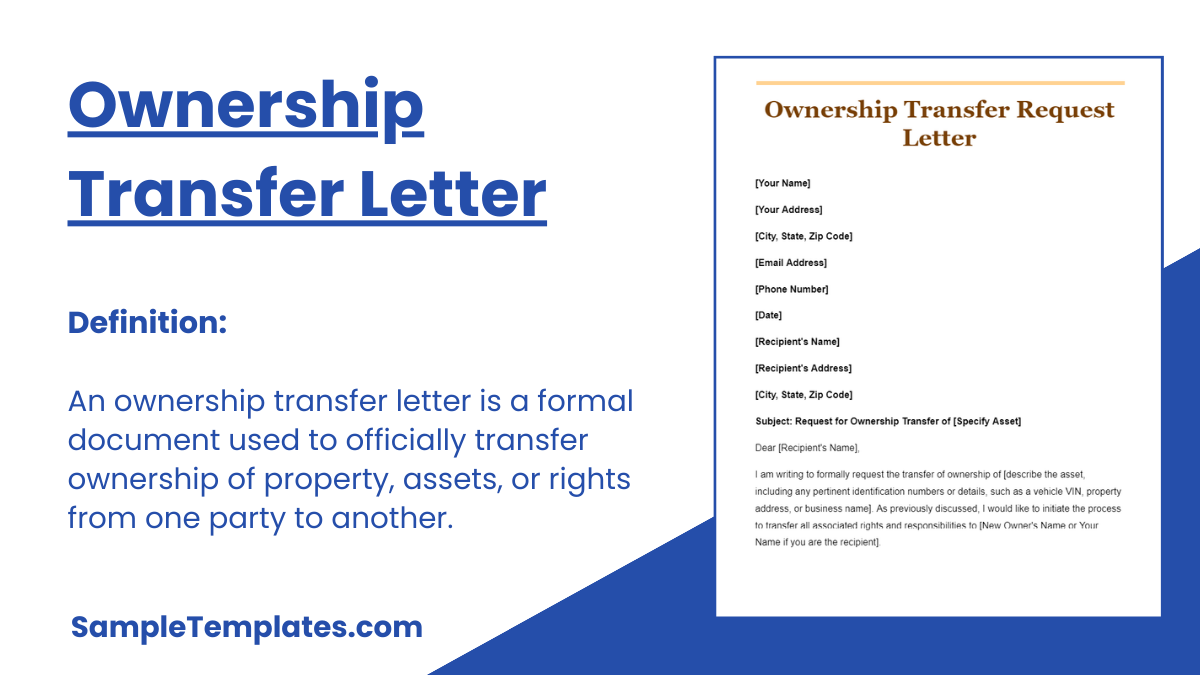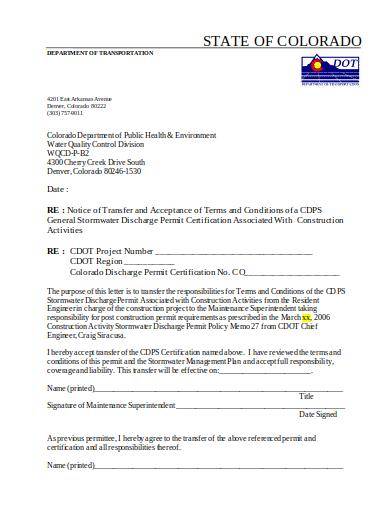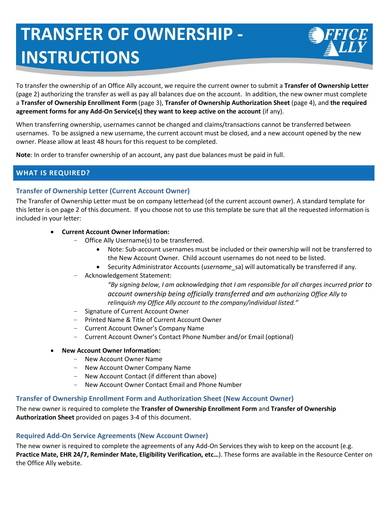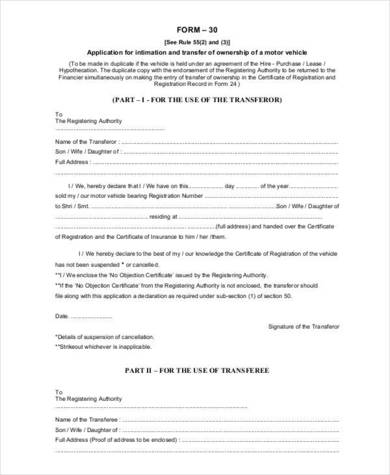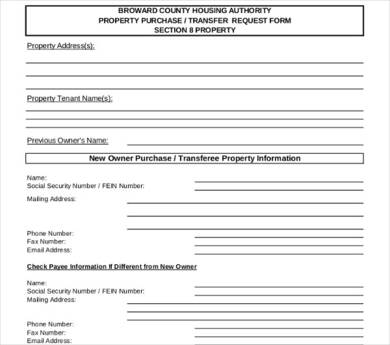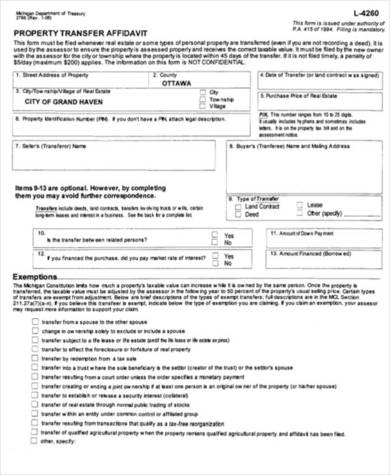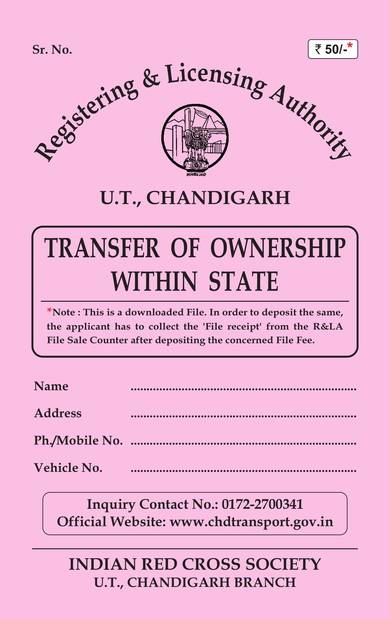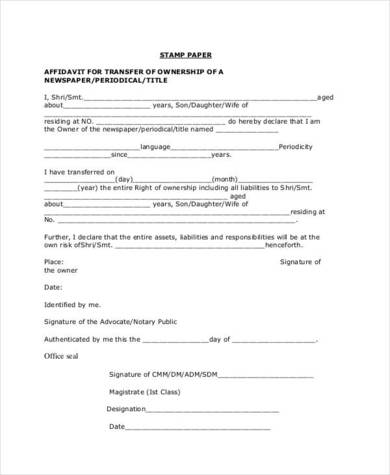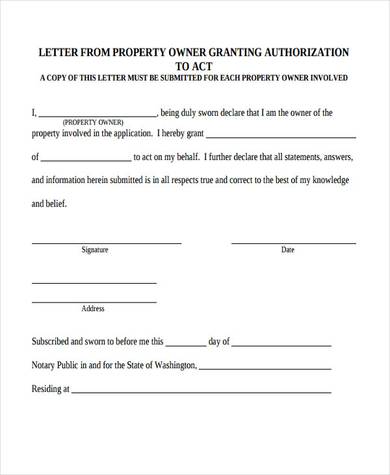There are many known uses of a transfer letter both for personal use and for use in business. As its name implies, a transfer letter is used to request something or someone to be transferred to another location, business, or person. An ownership transfer letter is a type of transfer letter that is specifically used to transfer the ownership and rights to a certain property or asset. There are many kinds of ownership transfer letters as each of them are used for different needs. Here are some samples that you might want to check out to help you learn and familiarize them.
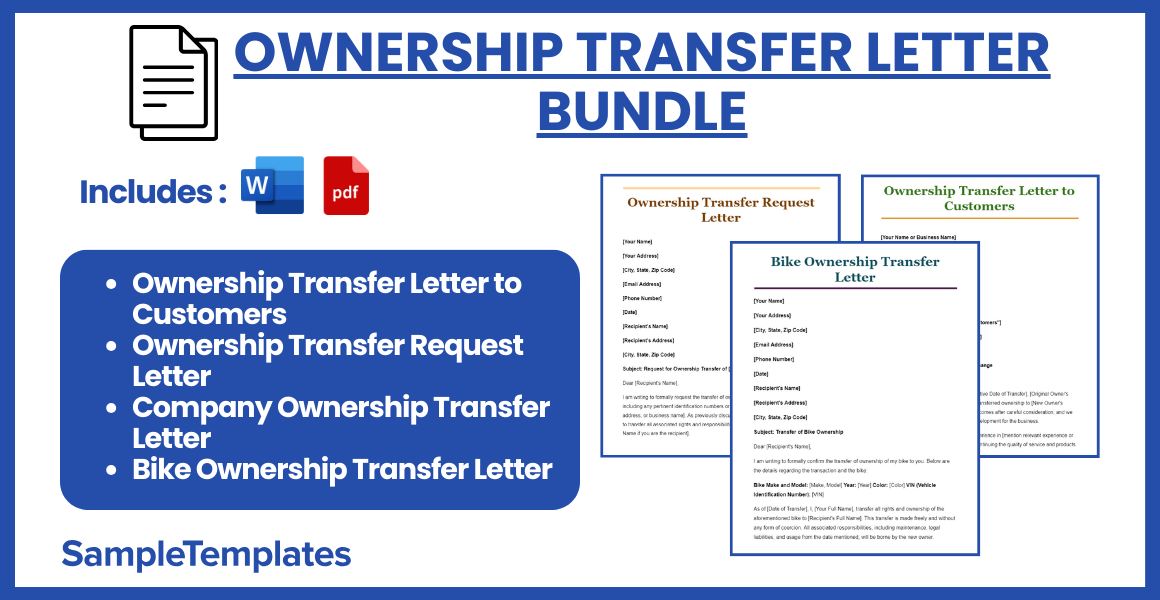
Download Ownership Transfer Letter Bundle
Ownership Transfer Letter to Customers
[Your Name or Business Name]
[Your Address]
[City, State, Zip Code]
[Email Address]
[Phone Number]
[Date]
[Customer’s Name or “To Our Valued Customers”]
[Customer’s Address or General Address]
[City, State, Zip Code]
Subject: Announcement of Ownership Change
Dear [Customer’s Name/Valued Customer],
We are writing to inform you that as of [Effective Date of Transfer], [Original Owner’s Name/Your Company Name] has officially transferred ownership to [New Owner’s Name/New Company Name]. This decision comes after careful consideration, and we believe it stands as a significant positive development for the business.
[New Owner’s Name] brings a wealth of experience in [mention relevant experience or background] and is committed to not only continuing the quality of service and products you have come to expect but also to making further improvements that will enhance your experience with us.
We want to assure you that this transition will not affect our operations or your relationship with us. All current contracts, agreements, and terms of service will remain in effect as per existing conditions, and you can expect the same dedication and quality in our engagements.
Our management and support teams remain as committed as ever to fulfilling your needs and ensuring your satisfaction. [Optionally, add information about any planned improvements or changes in operation or customer service.]
We understand that a change in ownership might raise some questions or concerns. Please feel free to reach out to us directly at [Your Contact Information or New Owner’s Contact Information], and we would be happy to discuss any aspect of this transition or any other inquiries you may have.
Thank you for your continued support and trust in [Business Name]. We look forward to serving you under this new ownership and believe that our future is bright with the opportunities this change will bring.
Sincerely,
[Your Signature (if sending a hard copy)]
[Your Name] [Your Position, if applicable]
[New Owner’s Name, if applicable]
[New Owner’s Position, if applicable]
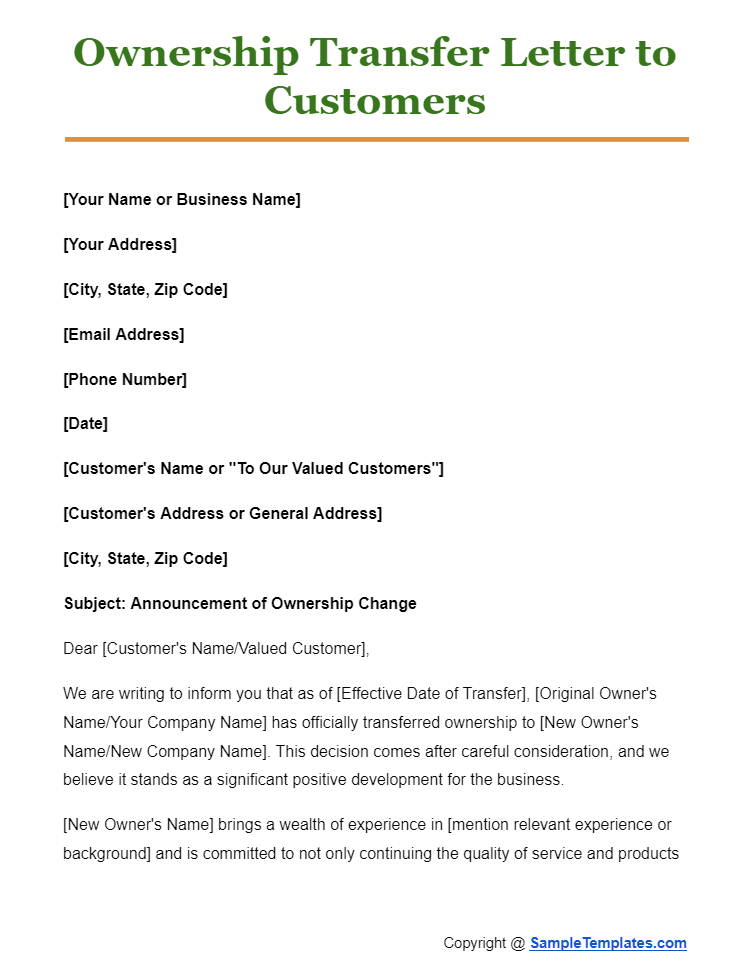
Ownership Transfer Request Letter
[Your Name]
[Your Address]
[City, State, Zip Code]
[Email Address]
[Phone Number]
[Date]
[Recipient’s Name]
[Recipient’s Address]
[City, State, Zip Code]
Subject: Request for Ownership Transfer of [Specify Asset]
Dear [Recipient’s Name],
I am writing to formally request the transfer of ownership of [describe the asset, including any pertinent identification numbers or details, such as a vehicle VIN, property address, or business name]. As previously discussed, I would like to initiate the process to transfer all associated rights and responsibilities to [New Owner’s Name or Your Name if you are the recipient].
This request follows our agreement on [briefly describe the basis of the transfer, such as a sale, a settlement, or a gift]. To ensure a smooth transition, I have outlined the steps we need to take:
- Completion of Transfer Documents: All necessary legal documents must be signed and notarized where required. I have attached a list of these documents for your review.
- Settlement of Any Outstanding Obligations: If applicable, any outstanding payments or obligations related to the asset should be settled by [set a specific date].
- Official Transfer Date: I propose that the official transfer date be set for [suggest a date], subject to your agreement. This will allow ample time for all paperwork and requirements to be completed.
- Notification to Relevant Parties: Upon completion of the transfer, it is essential to notify all relevant parties, including [list any relevant authorities or parties related to the asset, like the DMV, property records office, etc.].
Please review the proposed steps and attached documents, and let me know if there are any additional requirements or modifications you would like to suggest. It is my intention to make this transfer as straightforward and timely as possible.
If you agree with the proposed details, please confirm by signing and returning the attached letter of intent along with any other required documents by [give a return date]. Should you have any questions or need further clarification, do not hesitate to contact me directly at [your phone number] or [your email].
Thank you for your attention to this matter. I look forward to your prompt response and to finalizing this transfer efficiently.
Sincerely,
[Your Signature (if sending a hard copy)]
[Your Printed Name]
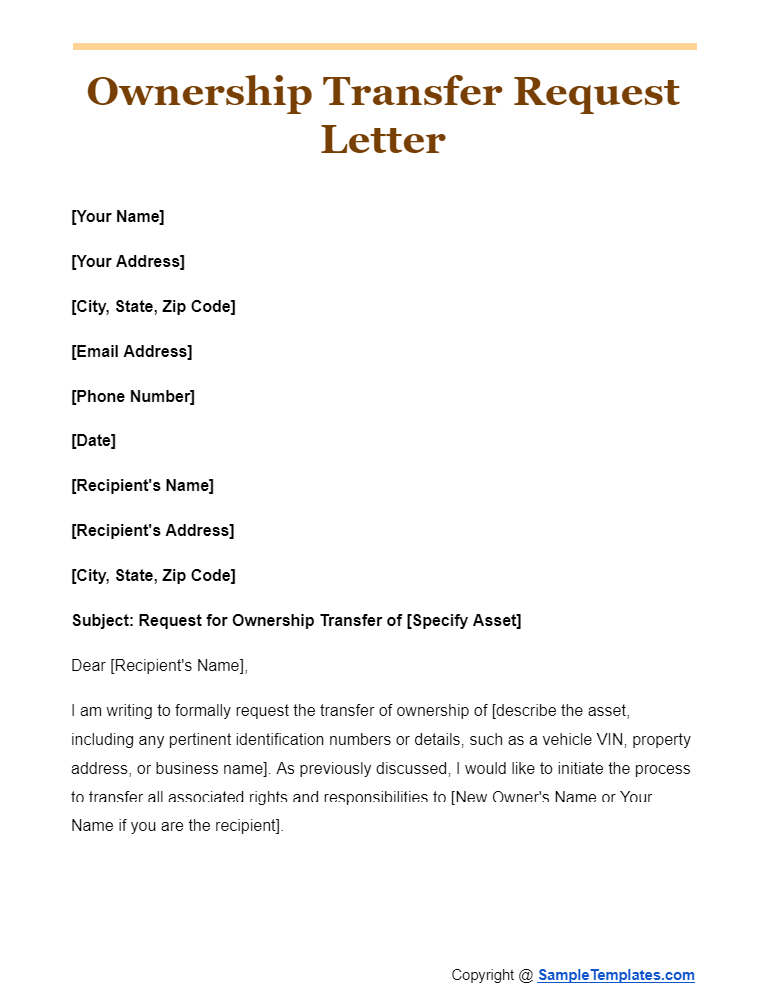
Company Ownership Transfer Letter
[Your Name]
[Your Title]
[Company Name]
[Company Address]
[City, State, Zip Code]
[Email Address]
[Phone Number]
[Date]
[Recipient’s Name or General Salutation like ‘Dear Stakeholders’]
[Recipient’s Title or ”]
[Recipient’s Company or ”]
[Recipient’s Address or ”]
Subject: Notification of Ownership Transfer
Dear [Recipient’s Name or ‘Stakeholder’],
I am writing to formally announce that as of [Transfer Date], the ownership of [Company Name], previously held by [Previous Owner’s Name], has been officially transferred to [New Owner’s Name]. This decision was made [provide a brief reason for the transfer if applicable, e.g., due to retirement, strategic realignment, etc.].
[New Owner’s Name] brings a wealth of experience in [describe new owner’s background and relevant experience], and is enthusiastic about not only continuing the strong traditions we have established at [Company Name] but also implementing innovative strategies for growth and improvement.
Please be assured that this transition will not affect our existing agreements, obligations, or the quality of services we provide. All ongoing projects and services will continue as planned without interruption.
We are committed to making this transition as smooth as possible and have taken all necessary steps to ensure a seamless changeover. [New Owner’s Name] is eager to maintain and enhance the trusted relationships we have built with all our valued clients, suppliers, and partners.
We understand that a change in ownership might prompt questions or concerns. We encourage you to reach out to us directly at [Your Contact Information or New Owner’s Contact Information]. [New Owner’s Name] is looking forward to meeting you personally and discussing our future plans.
Thank you for your continued support and partnership. We are excited about what the future holds under the new ownership and believe that together, we can achieve great success.
Sincerely,
[Your Signature if sending a hard copy]
[Your Printed Name]
[Your Position]
[Company Name]
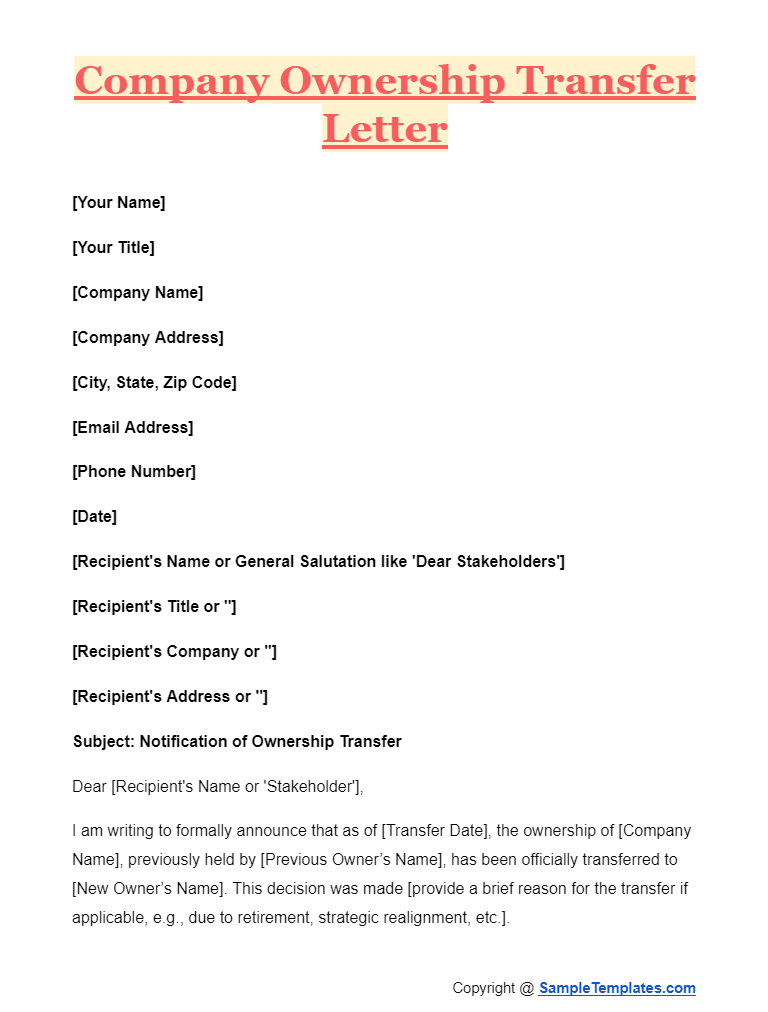
Bike Ownership Transfer Letter
[Your Name]
[Your Address]
[City, State, Zip Code]
[Email Address]
[Phone Number]
[Date]
[Recipient’s Name]
[Recipient’s Address]
[City, State, Zip Code]
Subject: Transfer of Bike Ownership
Dear [Recipient’s Name],
I am writing to formally confirm the transfer of ownership of my bike to you. Below are the details regarding the transaction and the bike:
Bike Make and Model: [Make, Model] Year: [Year] Color: [Color] VIN (Vehicle Identification Number): [VIN]
As of [Date of Transfer], I, [Your Full Name], transfer all rights and ownership of the aforementioned bike to [Recipient’s Full Name]. This transfer is made freely and without any form of coercion. All associated responsibilities, including maintenance, legal liabilities, and usage from the date mentioned, will be borne by the new owner.
Terms of Transfer:
- Condition of Bike: The bike is transferred in its current condition, as inspected by the recipient.
- Payment Details: The bike is being transferred for [mention any payment involved or if it is a gift].
- Documents Provided: The necessary documentation, including the bike’s registration and any other relevant paperwork, is provided herewith.
Please sign and return one copy of this letter as an acknowledgment of the transfer. Should you require any further information or have questions regarding this transaction, do not hesitate to contact me directly at the number or email listed above.
Thank you for your cooperation. I hope you enjoy your new bike and wish you safe and pleasant riding.
Sincerely,
[Your Signature (if sending a hard copy)]
[Your Printed Name]
Acknowledgment by Recipient:
I, [Recipient’s Full Name], hereby acknowledge the receipt of the bike described above and confirm the transfer of its ownership from [Your Full Name] to myself as of [Date of Transfer].
[Recipient’s Signature (if sending a hard copy)]
[Recipient’s Printed Name]
[Date]
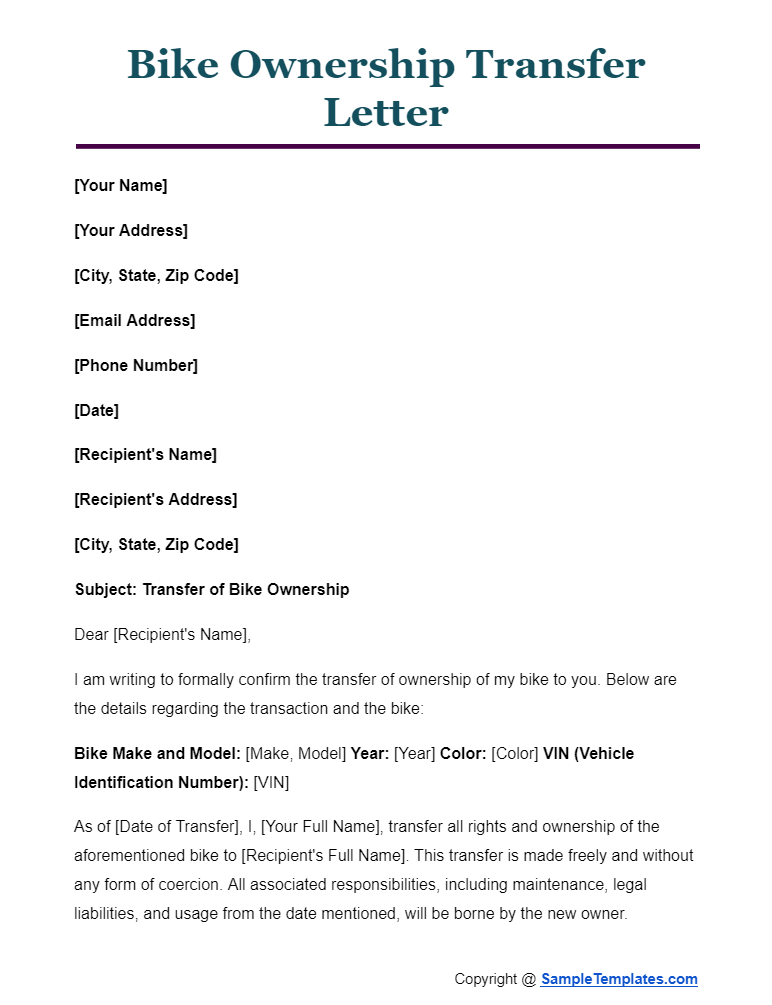
Browse More Templates On Ownership Transfer Letter
1. Sample Letter of Transfer of Ownership of Property PDF

2. Transfer of Ownership Letter
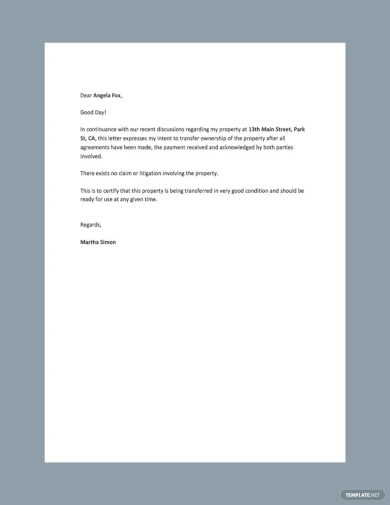
3. Change of Ownership Letter
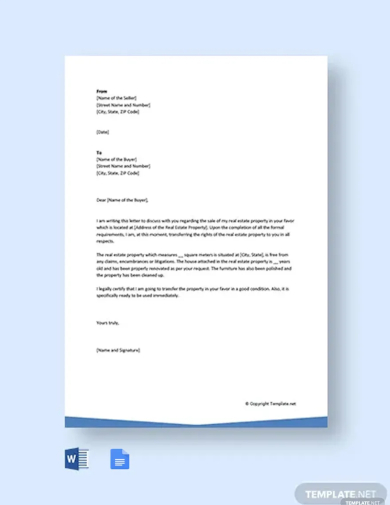
How to Write a Ownership Transfer Letter?
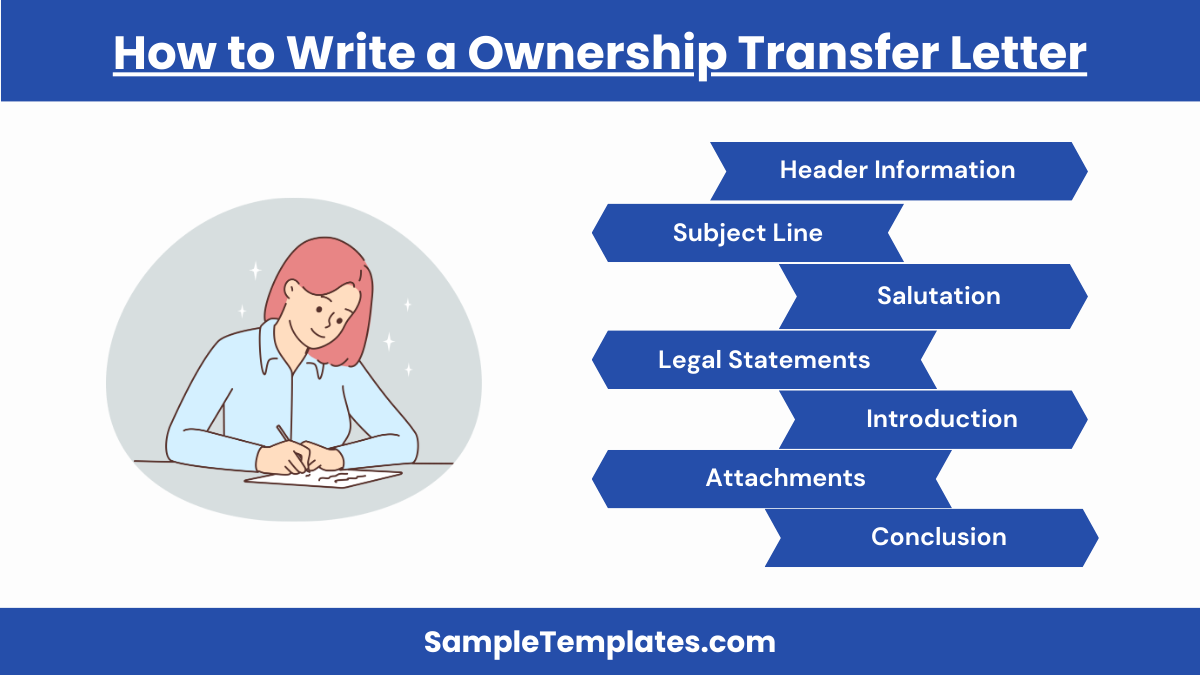
Writing an ownership transfer letter is a formal way to convey the transfer of ownership of property, assets, or a company from one party to another. This letter should be clear, detailed, and legally sound, especially since it often involves significant assets or responsibilities. Here’s a step-by-step guide on how to write an ownership transfer letter:
1. Header Information
- Date: Place the date at the top of the simple letter to mark when the transfer is officially communicated.
- Sender’s Information: Include the name, address, and contact information of the person or entity transferring the ownership.
- Recipient’s Information: Include the name, address, and contact information of the person or entity receiving the ownership.
2. Subject Line
- Clearly state the purpose of the letter. For example, “Transfer of Ownership of [Asset Name]”.
3. Salutation
- Address the recipient formally using “Dear [Recipient’s Name]” or a general greeting if the specific name is not known.
4. Introduction
- State the purpose of the letter succinctly. Mention the item, asset, or property being transferred.
5. Details of the Transfer
- Description of the Asset: Provide a full description of the asset, property, or responsibility being transferred.
- Terms and Conditions: Specify any terms or conditions that apply to the transfer, including any obligations on the part of the new owner.
- Transfer Date: Clearly specify the effective date of the ownership transfer.
- Reason for the Transfer (optional): While not always necessary, you can include a brief explanation of why the ownership is being transferred.
6. Legal Statements
- Include any legal language required to formalize the transfer, affirming that the document serves as a declaration of intent to transfer ownership.
7. Attachments
- Mention any documents attached to the letter, such as legal certificates, proof of ownership, transfer agreements, or other pertinent records.
8. Conclusion
- Reiterate the intent to transfer ownership and express hopes for a smooth transition. Invite the recipient to contact you if further information or clarification is needed.
9. Closing
- End with a formal closing such as “Sincerely” or “Best Regards,” followed by your signature and printed name.
10. Proofread
- Review the letter for any errors or omissions. Ensure all the information is accurate and clearly stated.
4. Property Transfer of Ownership Letter

5. Sample Letter of Transfer of Ownership of Business
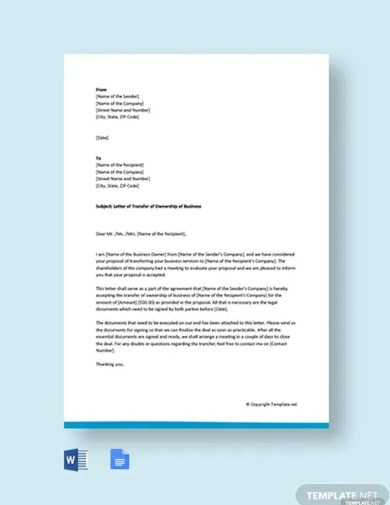
6. Ownership Letter
One of the uses of a transfer of ownership letter is to formally transfer the duties and responsibilities of one person to another. It also includes an acknowledgment from the person or individual taking ownership of the transferred duties and responsibilities. Since this letter is used in the state of Colorado, you will notice that it not only includes a letterhead but uses a formal letter format, making the said letter look professional and reliable. Signatures from both the involved individuals are also required in the letter.
Is there a Specific Form or Template for an Ownership Transfer Letter?
Certainly, while there isn’t a universally mandated ownership transfer letter template, a typical letter outline should contain essential information for a smooth transfer process. Begin with a formal salutation, clearly stating the intent to transfer ownership. Include detailed information about the asset, such as property or vehicle details, and specify the effective date of the transfer.
Provide names and addresses of both the current and new owners, along with their contact details. Clearly express the terms and conditions of the transfer, including any financial arrangements or considerations involved. If applicable, mention the reason for the transfer, such as sale, gift, or inheritance.
It’s crucial to reference the original purchase or acquisition details for the sake of clarity and to avoid any legal complications. Attach relevant supporting documents, like deeds, titles, or bills of sale, to substantiate the transfer.
Conclude the formal letter with a formal closing and invite any necessary responses or acknowledgments. While maintaining a professional tone, ensure the language is straightforward and easily understandable. It’s advisable to consult legal professionals or utilize templates specific to your jurisdiction to ensure compliance with regional laws and regulations governing ownership transfers.
Reasons For Ownership Change
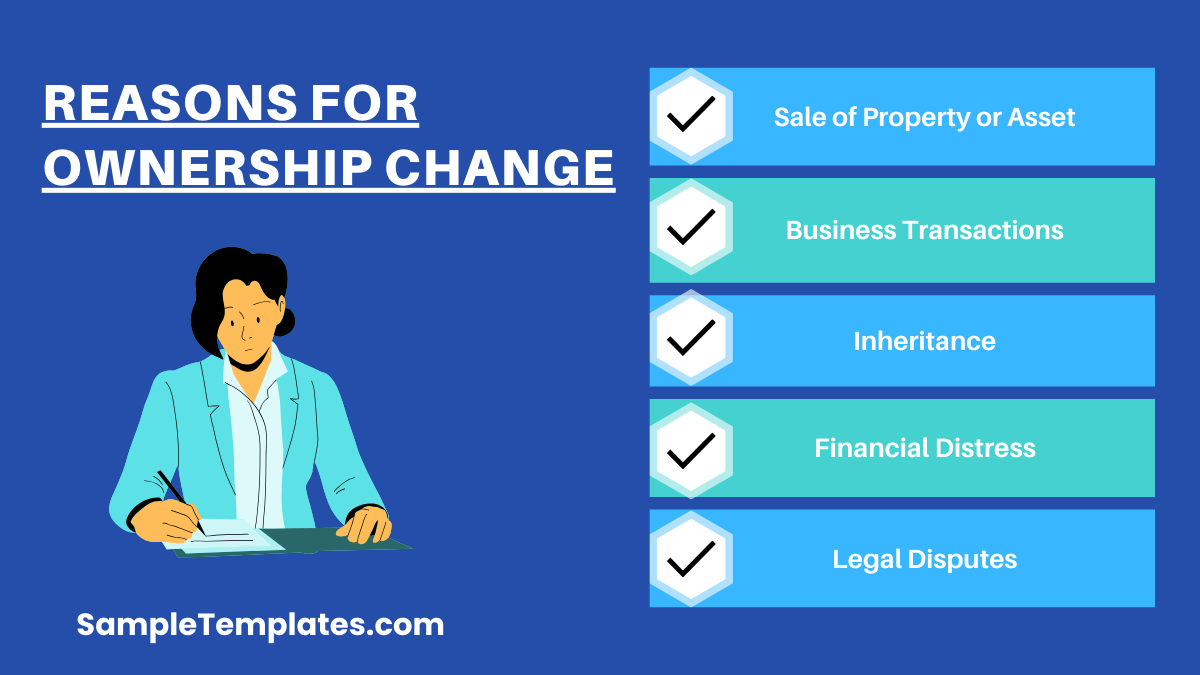
Ownership changes can occur in various contexts, including businesses, real estate, vehicles, and other assets. Here are several common reasons why ownership might change:
1. Sale of Property or Asset
- The most common reason for a change in ownership is the sale of an asset. Individuals or businesses decide to sell assets for various reasons such as upgrading, downsizing, or liquidating an investment.
2. Business Transactions
- Mergers and Acquisitions: A company may change ownership when it is bought or merged with another company. This can provide access to new markets, increase market share, or enhance operational efficiencies.
- Succession Planning: Ownership may transfer to a different party as part of a strategic plan for succession in family-owned businesses or private companies.
3. Inheritance
- Upon the death of an asset owner, ownership might transfer to heirs or beneficiaries according to the deceased’s will or, in the absence of a will, through probate according to state laws.
4. Gift
- Ownership of an asset may be transferred as a gift. This is common among family members, such as parents transferring property or a vehicle to their children without financial consideration.
5. Financial Distress or Bankruptcy
- Owners may change due to financial distress or bankruptcy. Assets might be sold to pay off creditors, or ownership may transfer as part of a bankruptcy settlement.
6. Legal Disputes
- Resolution of legal disputes can lead to changes in ownership if the courts decide that an asset should be transferred to another party as part of the resolution.
7. Government Seizure
- Ownership can change if a government seizes property through eminent domain for public use, or if assets are seized due to legal violations by the owner.
8. Divorce Settlements
- In the event of a divorce, assets owned jointly are often divided according to either an agreement between the parties or a court decision. This results in a change of ownership from joint to individual.
9. Restructuring or Liquidation
- In business, restructuring may involve the sale of portions of the business to new owners. Liquidation of a business involves selling the assets to various buyers as the company closes down.
10. Regulatory Requirements
- Sometimes, regulatory requirements might necessitate ownership changes. For example, certain industries might have caps on how much a single entity can own, requiring divestment.
These reasons highlight the diversity and complexity of scenarios that can lead to changes in ownership. Each case can have different legal, financial, and personal implications for the parties involved.
7. Ownership Letter Sample
Trying to write a transfer of ownership letter on your own for the very first time might be hard and trying, but you can always get away from this problem if you know which sample letter to look for and use as your reference. For your convenience, we recommend you try this transfer of ownership letter template shown above. Why this template? It’s because it includes instructions that will help you easily formulate your own letter without all the fuss.
What Documents are Required for a Smooth Ownership Transfer?
For a seamless ownership transfer, ensuring the proper documentation is essential. The specific documents needed may vary depending on the type of asset, such as real estate, vehicles, or businesses. Generally, the following documents are commonly required:
- Original Ownership Documents: These include the current title deed, vehicle registration, or business ownership certificates. These documents establish the current owner’s legal rights.
- Transfer Deed or Bill of Sale: A formal document outlining the terms and conditions of the transfer, signed by both the current and new owners. It serves as legal proof of the transaction.
- Identification Proof: Valid identification documents of both parties, such as passports or driver’s licenses, to verify their identities.
- No Objection Certificate (NOC): In some cases, a NOC from relevant authorities or financial institutions may be necessary, confirming there are no outstanding obligations or liabilities related to the asset.
- Financial Transaction Records: Proof of payment for the transfer, whether it’s a sale amount, transfer fees, or taxes associated with the transfer.
- Power of Attorney (if applicable): If one of the parties cannot be present during the transfer, a legally executed Power of Attorney may be required to delegate authority for the transfer process.
Ensuring that all required documents are in order and properly executed is crucial for a smooth ownership transfer, minimizing potential legal issues and ensuring a clear transition of ownership rights. Consulting with legal professionals or relevant authorities can provide additional guidance based on the specific nature of the asset being transferred.
8. Request Letter to Transfer Ownership of Property
This sample is intended for use by public authorities to officially acknowledge the transfer of ownership and custody of public records. This three-page sample can be customized according to one’s use and preferences as it is available in Word. You can easily add or remove information that you think are relevant or irrelevant to the letter. Keeping such sample letter will be beneficial to both parties involved as it serves as a documentation of the transfer and acknowledgment of the transaction.
What Information Should be Included in a Property Ownership Transfer Letter?
In a property ownership transfer letter, clarity and precision are vital to ensure a smooth transition. Begin with the sender’s and recipient’s details, including names, addresses, and contact information. Explicitly state the intention to transfer ownership, specifying the property’s full address and relevant details like lot number or legal description.
Include the agreed-upon transfer date and any conditions or terms associated with the transfer. If financial transactions are involved, outline the agreed-upon amount and the payment method.
Clearly express the transferor’s intent to relinquish all rights, title, and interest in the property, transferring them to the recipient. If applicable, detail any outstanding obligations, like mortgage balances or property taxes, and clarify how these will be handled in the transfer.
Both parties should sign and date the letter, acknowledging their understanding and sample agreement with the terms. It’s prudent to consult legal professionals to ensure the letter aligns with local property laws and regulations.
Overall, the property ownership transfer letter serves as a legal and formal document, providing a comprehensive record of the transfer process, protecting the interests of both the transferor and the recipient.
9. Vehicle Transfer Letter Format
When buying any type of vehicle, either from a dealership or from an individual you might know, a deed of sale or a car sale contract will always be present in the transaction. These documents may not be enough and you may need an ownership transfer letter to get things done right. A transfer of ownership letter for a vehicle can also be used for vehicles that have been gifted or given to another individual aside from the registered individual. Regardless of your reason for transferring ownership of a vehicle, you can also check out the sample above as your reference or use it as your own template.
What is the Process for Drafting a Business Ownership Transfer Letter?
Drafting a business ownership transfer letter involves a strategic and comprehensive process to ensure clarity and legal compliance. Start with a formal salutation, addressing the current owner and the prospective new owner. Clearly state the purpose of the letter: the transfer of ownership.
In the body of the formal letter, provide detailed information about the business, including its name, location, and any relevant identification numbers. Specify the terms of the transfer, such as the percentage of ownership being transferred, the agreed-upon purchase price, and the effective date of the transfer. If there are any conditions or contingencies associated with the transfer, articulate them clearly.
Include a section detailing the responsibilities and obligations of both parties post-transfer. If there are any contractual or legal documents accompanying the transfer, mention them and attach copies for reference.
Conclude the letter with a call to action, encouraging both parties to seek legal advice and sign the document to formalize their agreement. It’s advisable to involve legal professionals to ensure compliance with business laws and regulations.
A well-crafted business ownership transfer letter serves as a crucial record, minimizing potential disputes and providing a clear historical account of the business’s ownership transition.
10. House Ownership Transfer Letter Sample
After buying a house, you will need to transfer the house title and all other house documents under your name so that you will become its legal and rightful owner. To do that you will need a house sale contract and a house property transfer request form, just like the sample shown above. You will need to supply the required information in the form to complete it and before finally submitting it to your county’s housing authority. Downloading and printing the form online will make your task easier and more convenient.
11. Transfer of Property Letter
Another property transfer letter that you can use, if applicable to your country or state, is this property ownership transfer letter template. The sample is used primarily for real estate property transfers but can still be used for other types of personal property sheet transfers. It consists of a total of two pages, with the second page containing instructions and law excerpts that are useful to whoever will be using the sample template. The sample template itself is used and recommended by the Michigan Department of Treasury, so you can guarantee that it is reliable.
Can you Guide me on Writing a Formal Ownership Transfer Letter for a Company Asset?
Certainly! Writing a formal ownership transfer letter for a company asset involves careful consideration of details to ensure clarity and legal validity. Begin with a professional salutation, addressing the recipient formally. Clearly state the purpose of the letter, emphasizing the intention to transfer ownership of the specified asset.
Include essential details such as the asset’s description, unique identification numbers, and any pertinent transaction information. Explicitly mention the effective date of the transfer to establish a clear timeline. If there are any conditions or terms associated with the transfer, outline them comprehensively.
Affirm the willingness to provide any necessary documentation or cooperation during the transition. Conclude the letter with a polite expression of gratitude and contact information for any further inquiries or clarifications. Ensure the language is concise, precise, and adheres to legal norms.
Remember to keep a copy of the letter for records, and consider consulting legal professionals to ensure compliance with relevant regulations. This approach not only fosters transparency in business dealings but also minimizes potential disputes by clearly outlining the terms of the ownership transfer.
Who are the Required Signatories for an Ownership Transfer Letter?
The required signatories for an ownership transfer letter typically involve the current owner or seller and the intended new owner or buyer. Both parties must sign the document to indicate their agreement to the transfer of ownership. This ensures a formal and legally binding acknowledgment of the transaction.
In some cases, additional signatories may be necessary based on the nature of the ownership transfer. For instance, if the transfer involves a business entity, representatives or authorized personnel from both the selling and buying organizations may need to sign the letter. Legal or financial advisors may also be required to sign as witnesses, adding an extra layer of validation to the transfer process.
The signatures of all relevant parties contribute to the authenticity and enforceability of the ownership transfer. Additionally, it helps prevent disputes or misunderstandings by confirming that all involved individuals or entities are in agreement with the terms and conditions outlined in the transfer letter. It is advisable to consult legal professionals during this process to ensure compliance with local regulations and to provide comprehensive protection for both the seller and the buyer in the transfer of ownership.
12. Transfer of Ownership within State Template
This transfer of ownership document is pretty detailed and thorough as it not only provide templates, but there are also step-by-step instructions, checklists, general instructions for filling and submission, and relevant sample forms that are used to complete an ownership transfer transaction with the state. It’s a convenient bundle sample you surely wont’ regret downloading. If you get this sample, you will get hold of a total of 24 pages of all useful documents that will make your life easy and convenient.
13. Sample Letter of Ownership of Business
Whether you are transferring ownership of part of your business or an entire business to another entity, it is best to always have a business ownership transfer letter ready. This is one way for you to make the transaction formal and legal notice. It also documents the participation and acknowledgment of both parties in the said transfer transaction.
How is the Transfer of Ownership Confirmed in the Letter?
The transfer of ownership is typically confirmed in the letter through a clear and unambiguous statement outlining the specifics of the transfer. The language used in this section should explicitly convey the intent and details of the ownership change. Common elements include the names of the parties involved, the effective date of the transfer, and a concise description of what is being transferred, whether it’s the entire ownership, a percentage, or specific assets.
The confirmation may also include any conditions or terms agreed upon during negotiations. This section serves as a legally binding agreement, solidifying the understanding between the current and new owners. It’s vital to use precise language to avoid ambiguity and ensure all parties involved have a shared understanding of the transaction.
Additionally, the confirmation often emphasizes that the transfer is complete upon acceptance of the letter, and any further legal or regulatory requirements are expected to be fulfilled promptly. This clarity helps in avoiding misunderstandings and sets the stage for a smooth transition of ownership rights and responsibilities. Including signatures from both parties, along with the date, reinforces the authenticity and legality of the transfer confirmation within the ownership transfer letter.
14. Sample Authorization Letter to Transfer Ownership of Property
If you need to grant someone authority to act on your behalf regarding a particular property, then this sample letter declaring such will be of great help to you. The wordings in the sample are short and straightforward so you will find it easy to use and understand.
15. Ownership Transfer Letter Format
Use this transfer of ownership letter format either as a reference or as your own template in making an ownership transfer letter. The sample is only three pages long and consists of details, like description of the property rights, merchandise and services, owner affirmation and attestation, assignment of rights and ownership, etc.
What is a Letter of Acceptance for Ownership Transfer?
A letter of acceptance for ownership transfer is a formal document acknowledging the acceptance of the transfer of ownership of a property, asset, or responsibility from one party to another. It confirms the recipient’s agreement to assume ownership and any associated terms or conditions.
How Do I Write a Letter to Change Ownership of a Bank Account?
- Address the bank professionally.
- Include your account details and request for ownership change.
- State the reason for the change.
- Provide the new owner’s information.
- Mention any required documents.
- Offer to cooperate with the bank’s process.
- Include contact information for queries.
- Close the letter formally and sign it.
What is a Letter of Ownership?
A letter of ownership is a document that confirms and provides evidence of an individual’s or entity’s legal ownership of a specific property, asset, or rights. It may include details about the owner’s identity, the property or asset in question, and any relevant terms or conditions of ownership.
What is Ownership Transfer?
Ownership transfer refers to the process of changing the legal rights and responsibilities of owning a property, asset, or entity from one party to another. It involves transferring the title, control, or rights associated with the ownership of something from the current owner to a new owner.
In conclusion, this letter serves as a formal documentation of the transfer of ownership. It confirms that all rights and responsibilities associated with the asset have been duly transferred to the new owner. For any further clarifications or actions, please feel free to contact me directly.
Related Posts
Payment Letter Formats Samples & Templates
Business Proposal Letter to Client Samples & Templates
Company Introduction Letter Samples & Templates
Resignation Letter for Medical Samples & Templates
Letter of Intent Samples & Templates
Letter of Intent for a Job Samples & Templates
Lease Proposal Letter Samples & Templates
Letter of Inquiry Samples & Templates
Character Reference Letter Samples & Templates
Claims Letter Samples & Templates
Response Letter Sample & Templates
Follow Up Letter Samples & Templates
Sample Project Proposal Letter Templates
Donation Letter Samples & Templates
Addressing a Formal Letter Samples & Templates
